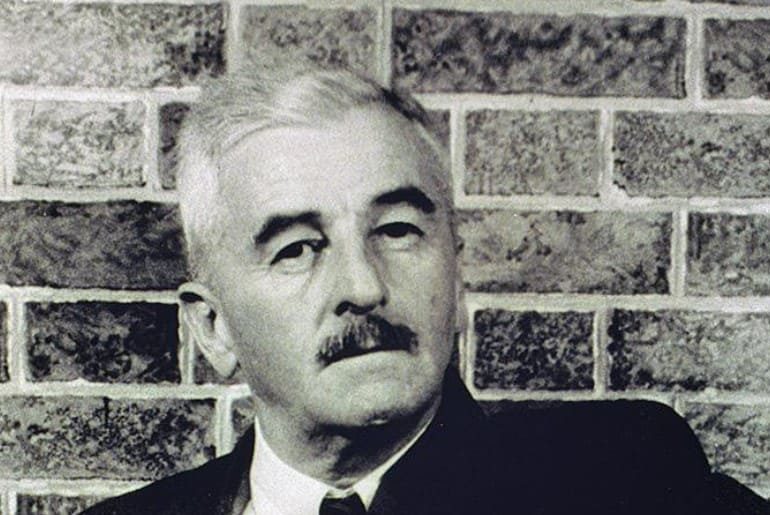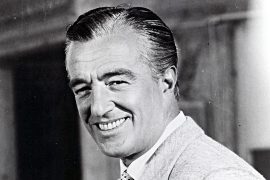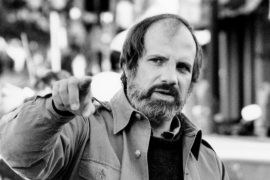He revolutionized the novel, but also wrote for Hollywood, he exposed the abysses of the American southern states – but he himself resided in the villa of a slave owner. William Faulkner was as contradictory as his characters.
Stockholm, December 8, 1950: William Faulkner stands on the podium in the auditorium of the Swedish Academy. A small man with a mustache and icy hair. He has just been awarded the Nobel Prize for Literature. Faulkner wears tails, as was proper at the time, not his characteristic coarse tweed suit. He reads from the sheet. One seems to see his discomfort: William Faulkner never looked up during his speech. A man of the word, but not of the spoken. And certainly none for the podium, the world stage.
From the losers of modernization
No wonder, because the world Faulkner calls home is the world of the American South. More precisely: the small town of Oxford, Mississippi, where he has spent most of his life. The former wealth of the US state was earned at the expense of the black slaves who had to toil on the cotton plantations.
After the Civil War and the abolition of slavery, Mississippi experienced an unprecedented economic decline – the competitive advantage of cheap labor was gone. William Faulkner was born into this world in 1897. It shapes his novels: the guilt of white people for building their wealth on slavery. And the inability to get over defeat in the civil war.
Revolutionary storytelling
By the time the Nobel Prize was awarded, Faulkner had long since passed his prime as a writer. His two great novels were published 20 and 13 years earlier respectively. “Noise and madness”, the grandiose early work, a family history composed like a mosaic from different narrative perspectives. And “Absalom! Absalom!”, Faulkner’s Opus Magnum: also a family story, spanning several generations, also told from different perspectives. And at the same time the story of a fictional county in Mississippi, from settlement in the 1830s to the beginning of the 20th century.
“Noise and madness” consists of four chapters. Each has a different narrator with a different perspective and style of speaking. In 1929, when “Noise and madness” was published, this narrative structure was revolutionary. James Joyce and Virginia Woolf have already worked with the narrative technique of the stream of consciousness, in which the events are only described indirectly: through the thoughts, feelings and memories of the characters in the novel.
But Faulkner goes a few steps further: he creates the narrators extremely differently, fragments the chronological sequence and leaves the reader with key events and information important for understanding. This creates a mosaic that can only be deciphered in retrospect.
This polyphony is a hallmark of Faulkner’s style, Watson explains: “In doing so, he paid tribute to the fact that no one tells stories or even thinks them in a continuous and linear manner. That knowledge unfolds in spurts, just like stories. Faulkner had a basic understanding of the crisis of the ego. The ego is a dynamic phenomenon, constantly pressed, tense, contradictory, irrepressible, divided within itself. Faulkner portrayed this conflict in all of his novels.”
Contradiction between artist and citizen
As Bill Griffith knows, that didn’t exactly make him popular in his hometown of Oxford: “He wrote about things that other people here weren’t even willing to talk about, about racism, violence, adultery, about sin, debauchery and drunkenness. All of these things were not edifying and, according to popular belief at the time, should not be in novels.”
Griffith is curator at Rowan Oak, the antebellum home that William Faulkner bought in 1930 and where he lived until his death in 1961. Rowan Oak was built in 1844 by a cotton baron who owned numerous plantations down in the Mississippi Delta. He had made his fortune by exploiting black slaves.
“It’s the most fascinating contradiction in his life,” says Faulkner connoisseur Jay Watson. “In his novels and short stories, houses like this suffer terrible fates. They burn down, they fall into disrepair, the owners are evicted. As an artist he understood the compromised mansions of the early slaveholders, but as a citizen of Oxford he wanted to benefit from the status they promised in the society of the time. Basically, two completely different people lived there.”
Literally an anti-racist, politically a redneck
As much as Faulkner saw and described the abysses of Southern society, he was shaped by it himself. Not only in his way of life, as Griffith explains: “His financial situation was always tense. Faulkner had an idea of what a southern gentleman should have and do. And that’s what he cultivated: the posh lifestyle of the old South.”
Politically, too, in the 1950s he made strong those positions that he questioned in his books: “I was against enforced racial segregation. Now I am just as strongly opposed to forced racial integration,” Faulkner wrote in an open letter dated March 5, 1956. Three months earlier, later Nobel Peace Prize winner Martin Luther King organized the Montgomery Bus Boycott in response to the arrest of an African-American activist who refused to give up her seat on a bus for a white man.
Emmett Till, an African American teenager, was murdered in the summer of 1955. The killers, two white men, were acquitted by an all-white jury despite overwhelming evidence. Faulkner explicitly mentions the murder of Emmett Till in his letter. And describes it as the logical consequence of a Supreme Court ruling that found racial segregation in schools unconstitutional.
For William Faulkner, the civil rights movement would have been an opportunity to take sides in a just cause. Instead, he indulges in letters and interviews in crude historical theses, in paternalistic language and racist thoughts. He even announces that if in doubt he will “fight” for Mississippi and that he is willing to shoot black people to do so.
Writing against the lynching
In contrast to such statements is a novel like “Dust Grip”, published in 1948, which tells the story of a false suspicion: Lucas Beauchamp, an African-American plantation owner, is said to have murdered a white forest worker. A white mob then formed who wanted to lynch Beauchamp, i.e. hang him or burn him. Lynchings were common practice in rural areas of the United States well into the 1950s. Victims are mostly African American. According to estimates, a total of 4800 since the end of the American Civil War, 800 of them in Mississippi alone.
Finally, in the novel, a young white man whom Beauchamp once rescued from a creek proves his innocence. With an African American friend, he digs up the coffin of the forest worker. But the coffin is empty. The brother of the forest worker is finally arrested as the murderer.
Hollywood has made his writing more pictorial
At this time, Faulkner was already familiar with the film business: In 1931, William Falkner worked in Hollywood for the first time. As a screenwriter, like many writers of his time. The film industry promised good and, above all, fast and secure money – in contrast to months, sometimes years of lonely work on the next book, without the certainty of whether it will succeed or be a success. He worked on 20 films, seven of his own works were filmed during his lifetime.
In addition, he is also involved in the classics of film history – such as the cloak-and-dagger-schmonzette “The Love Adventures of Don Juan” or the monumental film “Land of the Pharaohs” – whose stories are far removed from the small world of his books, even if Faulkner negotiated major and, above all, universal issues there.
Nevertheless, his Hollywood experience has also shaped Faulkner’s literary and artistic work, says Jay Watson: “Literary scholars have worked out in studies that the visual dimension of his novels changed after Faulkner was in Hollywood for the first time. After that, he developed his stories more from images and less from sounds, as he did in the beginning when he was even more involved in the oral tradition of the South.”
Time for a Faulkner renaissance
Faulkner’s last novel came out in 1961: “The Reivers” takes place in Memphis, in the milieu of prostitutes and gamblers. The following year he suffered a serious riding accident, he had trained for weeks for a hunt. “He drank day and night to endure the pain in the weeks that followed,” says Bill Griffith. “Three weeks later, on July 6, 1962, he was not feeling well. He was admitted to a hospital. The next day he had a heart attack and died.”
William Faulkner was only 64 years old. His oeuvre spans 19 novels and has put the small town of Oxford, Mississippi on the literary map of the world. His early death can also be attributed to his lifestyle, says Griffith: “Faulkner smoked, drank and ate fried foods every day. You didn’t get older than 64 at the time. William Faulkner wasn’t alive for a long time, but it was a good one.”
While William Faulkner had a major influence on German post-war literature, on Heinrich Böll, Siegfried Lenz and Uwe Johnson, his novels are rarely read today, and not just in this country. Jay Watson thinks it’s time for a renaissance – right now, especially today: “Faulkner brings us closer to the dilemma of people who are confronted with dynamic transformation processes and abrupt changes. And that’s something that shapes our world today even more than the world he wrote about.”
What is William Faulkner best known for?
William Faulkner wrote numerous novels, screenplays, poems, and short stories. Today he is best remembered for his novels The Sound and the Fury (1929), As I Lay Dying (1930), Sanctuary (1931), and Absalom, Absalom!
What did William Faulkner win the Nobel Prize for?
The 1949 Nobel Prize in Literature was awarded the American author William Faulkner (1897–1962) “for his powerful and artistically unique contribution to the modern American novel.” “for his powerful and artistically unique contribution to the modern American novel.” The prize was awarded in 1950.
What does William Faulkner write about?
Faulkner became known for his faithful and accurate dictation of Southern speech. He also boldly illuminated social issues that many American writers left in the dark, including slavery, the “good old boys” club and Southern aristocracy.
What was William Faulkner’s writing style?
Stylistically, Faulkner is best known for his complex sentence structure. Generally, the more complex the sentence structure, the more psychologically complex a character’s thoughts.
What is William Faulkner most famous book?
- The Sound and the Fury 1929
- As I Lay Dying 1930
- A Rose for Emily 1930
- Light in August 1932
- Absalom, Absalom! 1936
- Barn Burning 1939
What is the best William Faulkner book to read first?
As I Lay Dying affords the reader, especially a first-time reader of Faulkner, more breathing space than a lot of Faulkner’s works do, and that is why I feel it is a perfect place to start with him.
What do I need to know before reading Faulkner?
- Be patient. Think of a Faulkner text as a suspense or mystery story — but with you the reader, instead of a character, as the detective.
- Be willing to re-read.
- Focus on the characters.
- Identify the historical context of the work.
- Look for the timeless tales.
Why should I read The Sound and the Fury?
With multiple narrators, narration styles, and dates, this story is bound to make your head spin at times (which might sound awful, but it’s actually really thought-provoking and fascinating and fun).
What should I read if I like Faulkner?
- Sherman Alexie.
- Sylvia Plath.
- Kate Chopin.
- James Joyce.
- Alice Walker.
- Emily Dickinson.
- Nathaniel Hawthorne.
- James Baldwin.
What are the first two books written by William Faulkner?
He then held various jobs in New York and Mississippi until 1924. Faulkner’s first published novel, Soldier’s Pay (1926), drew on his experiences in World War I (1914–1918), while Mosquitoes (1927) examined literary life in New Orleans (in 1925, Faulkner lived there with the writer Sherwood Anderson).





